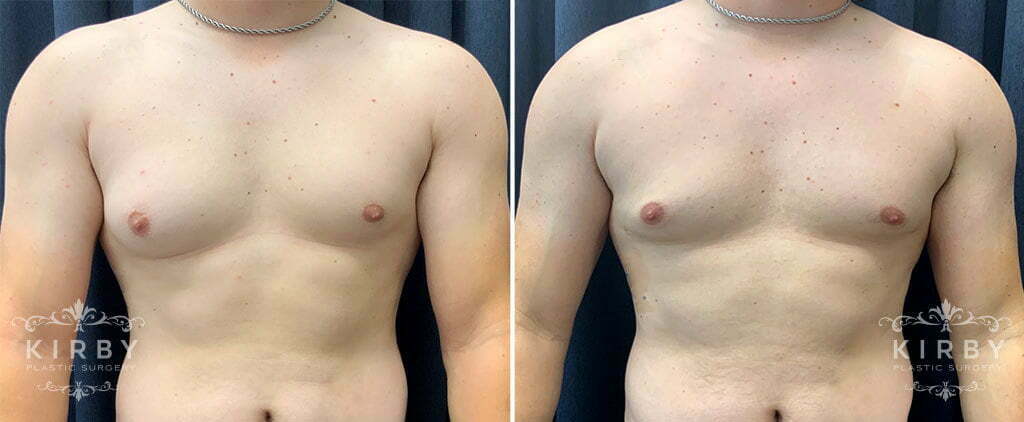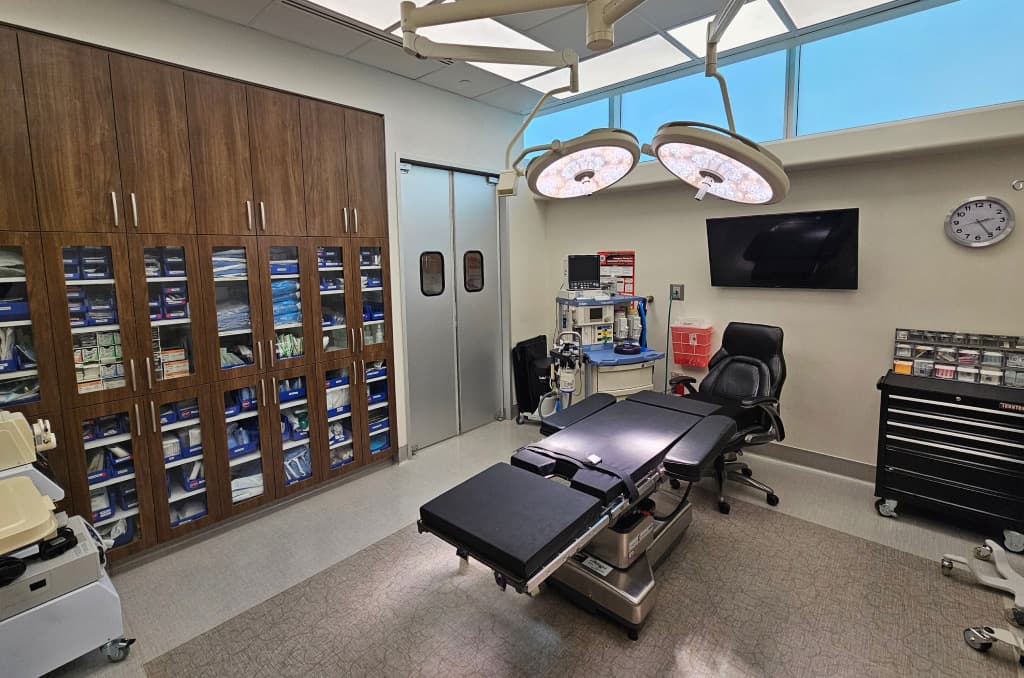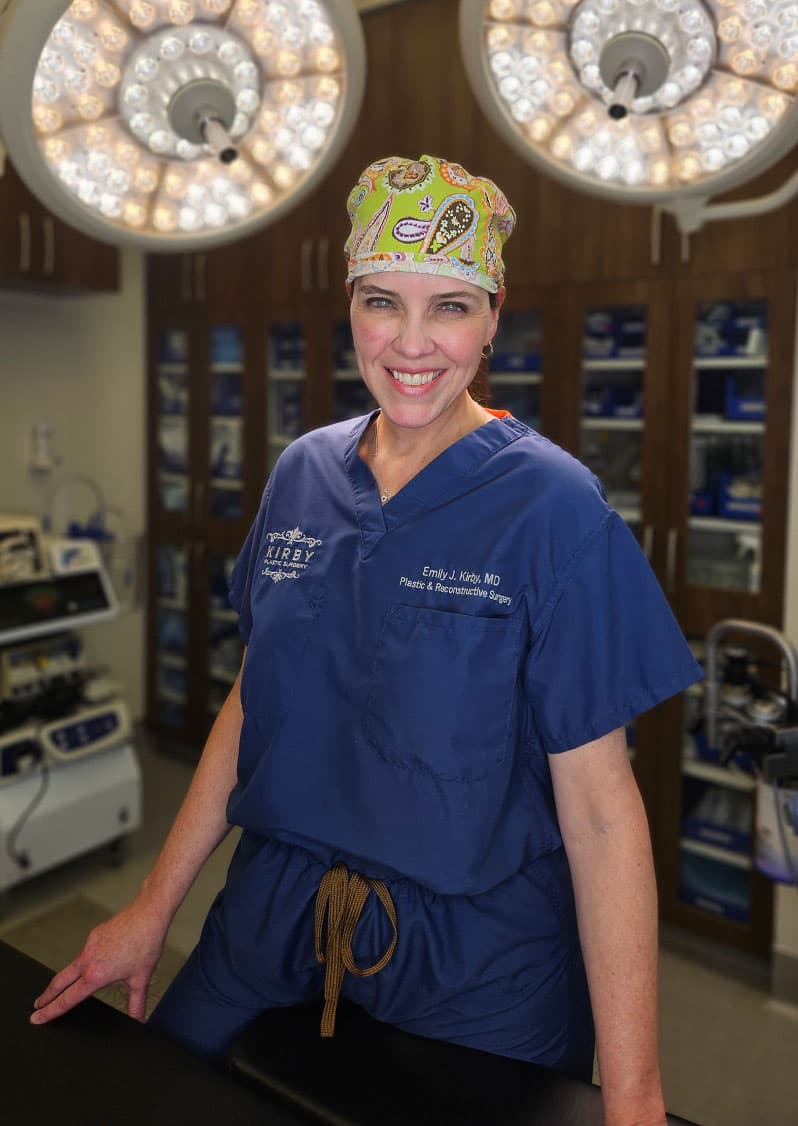Male Breast Reduction Surgery Fort Worth

As men age, their hormones can become imbalanced, leading to enlarged male breasts, a condition clinically referred to as gynecomastia. Up to 70% of men between the ages of 50 and 69, and 69% of adolescent males between the ages of 10 and 19, experience this uncomfortable and embarrassing condition. Board Certified Plastic Surgeon Dr. Emily J. Kirby performs male breast reduction surgery in Fort Worth to correct gynecomastia and restore a flat, firm, masculine appearance to the chest.
What is gynecomastia?
Gynecomastia is a common medical condition in which male breast tissue becomes enlarged due to an imbalance in estrogen and testosterone hormones. Gynecomastia can affect one or both breasts, and tenderness usually occurs directly beneath the nipple. This condition can be uncomfortable, embarrassing, and even painful.
Symptoms of gynecomastia
Symptoms of gynecomastia may include:
- Swollen breast tissue
- Tenderness and/or pain in the breast
- Nipple discharge
These symptoms range from mild to severe among men and adolescents.
Female Plastic Surgeon Fort Worth
- Board-Certified Plastic Surgeon
- Over 12 years of experience in private practice
- Founder and Medical Director of Kirby Plastic Surgery, Kalos Medical Spa, and City Surgery Center—a Quad A-accredited, state-of-the-art facility located onsite
- Specialist in breast surgery and body contouring, including postpartum
- Castle Connolly Top Doctor since 2019
- First female Chief of Plastic Surgery, Texas Health Resources Harris Methodist Hospital
Causes of gynecomastia
Gynecomastia can occur at various stages in a man’s life (after birth, at puberty, or during adulthood), and causes may include:
- Alcohol and/or drug use, particularly marijuana
- Aging
- Use of estrogen-promoting medications
- Use of performance-enhancing steroids containing testosterone
- Genetics
- Exposure to certain chemicals
- Kidney and/or liver disease
- Obesity
- Poor diet
The incidence of gynecomastia tends to increase in men as they reach their middle years. While there is a perception that only overweight men suffer from gynecomastia, it can also afflict slim men.
Real patient images from Board-Certified Plastic Surgeon Dr. Emily Kirby
*Individual results may vary.

Diagnosing gynecomastia
When diagnosing patients with gynecomastia, it is important that a doctor rule out breast and testicular cancers, as well as sex-hormone producing tumors, as possible diagnoses.
What does male breast reduction surgery involve?
While gynecomastia treatment with medications, radiotherapy, and exercise exist, surgery is considered to be the most lasting and effective treatment. Dr. Kirby performs male breast reduction surgery on site at her private, AAAASF-accredited surgery center in Fort Worth.
Male breast reduction surgery with liposuction
If your gynecomastia is mostly caused by excess fatty tissue, your male breast reduction surgery may require only liposuction, which is a minimally-invasive procedure. In men’s liposuction surgery, excess fat tissue is removed through small (1cm) incisions.
If localized fat deposits in other areas bother you, male breast reduction surgery can be combined with other liposuction procedures to address areas like the love handles and abdomen.
Male breast reduction surgery with tissue excision
In cases of gynecomastia that involve enlarged glandular tissue, tissue excision may be necessary. This procedure is slightly more extensive than liposuction and involves removal of excess glandular breast tissue, typically through a semicircular incision around the areola (the pigmented skin around the nipple). The scar after this procedure is usually discreet and appears to be part of the nipple itself. Occasionally, excess skin associated with gynecomastia may need to be removed using longer incisions.
- Key Benefits
- Glossary
- Creates a flatter, more traditionally masculine chest contour
- Allows you to wear tighter fitting clothes or swimwear with confidence
- Provides long-lasting results, given you maintain a stable weight and healthy lifestyle
- Customizable, whether your gynecomastia is caused by fatty or glandular tissue
- Body Contouring: A range of procedures aimed at reshaping and refining the body’s contours, often used in conjunction with male breast reduction to achieve a more aesthetically pleasing overall physique, especially when addressing gynecomastia along with other areas of fat accumulation.
- Excision: The surgical removal of tissue; in the context of male breast reduction, excision is used to remove glandular breast tissue that cannot be effectively treated through liposuction alone.
- Glandular Tissue: The firm and dense tissue found in the male breasts, often responsible for gynecomastia; differs from fatty tissue in texture and location.
- Gynecomastia: A condition characterized by the enlargement or swelling of breast tissue in males, often due to hormonal imbalances, medication, or other factors.
- Hormonal Imbalance: A common cause of gynecomastia, involving an imbalance between estrogen and testosterone levels in the male body.
- Liposuction: A surgical procedure that removes excess fat from the body. In male breast reduction, liposuction is often used to remove fatty tissue contributing to the appearance of enlarged breasts.
- Local Anesthesia: Medication administered to prevent pain during surgery by numbing a small area; it may be used in combination with sedation during male breast reduction surgery to minimize discomfort if preferable over general anesthesia.
- Mastectomy: The surgical removal of one or both breasts, partially or completely. In the context of male breast reduction, a less extensive form of mastectomy is performed to remove breast tissue.
- Pseudogynecomastia: A condition where the enlargement of male breasts is due primarily to excess fatty tissue rather than glandular tissue, often addressed with liposuction.
- Recovery Time: The period after surgery during which the patient heals. This includes time for swelling and bruising to subside, and for the patient to gradually return to normal activities, typically ranging from a few days to several weeks. Recovery can be streamlined, but not rushed.
- Scar Management: Techniques and treatments used to minimize the appearance of scars following surgery, important in male breast reduction for achieving a discreet surgical outcome.
- Sedation Anesthesia: Medication that induces a state of relaxation and partial sleepiness, often used in combination with local anesthesia during male breast reduction surgery for patient comfort.
- Subcutaneous Tissue: The layer of tissue just beneath the skin, containing fat cells, which may be removed during male breast reduction to improve chest contour.
“I would let you operate on me again or any of my family any time!“
Should I have male breast reduction surgery for gynecomastia?
If you are seeking a long-term solution to your gynecomastia and are in generally good health, surgery may be the right treatment option for you. Male breast reduction surgery has a very high patient satisfaction rating; in a study of 27 male participants who underwent gynecomastia surgery, the majority rated their experience a 9 out of 10. Our patients report having increased confidence and appreciation for their appearance following breast reduction surgery.
What are the risks of male breast reduction surgery?
Gynecomastia repair is a safe and effective surgery, but as with any surgical procedure, complications may occur in rare cases. These may include numbness, excessive swelling and/or bruising, loss of the nipple (nipple necrosis), or loss of nipple skin (areolar necrosis).

City Surgery Center
Our on-site, accredited surgical suite
Instead of heading to a hospital or other public surgical facility for your procedure, you can enjoy the privacy and luxury of our on-site operating room, designed to facilitate safe, top-quality care in a spa-like setting.
How do I prepare for gynecomastia surgery in Fort Worth?
To prepare for your Fort Worth breast reduction surgery, Dr. Kirby recommends eating a healthy diet, drinking plenty of water, getting plenty of restful sleep, and refraining from smoking or using nicotine products. In the weeks prior to surgery, Dr. Kirby will direct you to stop taking certain medications that may hinder blood clotting, including aspirin and aspirin products (Alka-Seltzer®, Carisoprodol, Excedrin®, Goody’s®), anti-inflammatory medications (except acetaminophen, or Tylenol®), and herbal supplements.
“Thank you to Dr. Kirby and team for the amazing work and service I received. Your work is truly a piece of art! I will be sharing your name with all of my friends.”
What kind of anesthesia will I have?
Dr. Kirby typically uses general anesthesia to provide maximum comfort for her patients during gynecomastia surgery. You will be fully asleep for the entire procedure.
How long will my breast reduction surgery last?
Male breast reduction surgery is performed as an outpatient procedure and normally takes anywhere from 45 minutes to 2 hours, depending on your type of procedure. After you wake up from anesthesia, you will be able to go home to recover on the same day.
Dr. Emily Kirby uses Enhanced Recovery After Surgery (ERAS) protocols, also known as “multimodal analgesia,” to minimize recovery time, and we see real results: our patients experience less nausea and feel more alert, mobile, and comfortable after their procedures.
“I had very hard recoveries in the past…it took me weeks to get back to caring for my family. With Dr. Kirby, I had a wonderful recovery and was back to my activities surprisingly quickly. Don’t tell the doctor, but I was at my child’s sporting event the day after my surgery, and I felt great!”
—Real patient of Dr. Kirby
What is recovery from breast reduction surgery like?
Most men return to work within a few days of undergoing breast reduction surgery. Dr. Kirby usually recommends patients refrain from vigorous exercise for the first 4 to 6 weeks and wear a compression vest to help the tissue heal and prevent fluid from accumulating in the chest. Some swelling and bruising in the chest is normal during this recovery period and can be lessened with prescription or over-the-counter medications. Depending on the extent of your procedure, Dr. Kirby may further personalize your recovery recommendations.
References »
Johnson RE, Kermott CA, Murad MH. Gynecomastia – evaluation and current treatment options. Therapeutics and Clinical Risk Management. 2011;7:145-8. doi: 10.2147/TCRM.S10181.
Taheri AR, Farahvash MR, Fathi HR, Ghanbarzadeh K, Faridniya B. The Satisfaction Rate among Patients and Surgeons after Periareolar Surgical Approach to Gynecomastia along with Liposuction. World Journal of Plastic Surgery. 2016 Sep;5(3):287-292.
Sansone A, Romanelli F, Sansone M, Lenzi A, Di Luigi L. Gynecomastia and hormones. Endocrine. 2017 Jan;55(1):37-44. doi: 10.1007/s12020-016-0975-9.
Soliman AT, De Sanctis V, Yassin M. Management of Adolescent Gynecomastia: An Update. Acta Biomedica. 2017 Aug 23;88(2):204-213. doi: 10.23750/abm.v88i2.6665.
- Discuss your goals and concerns
- Obtain an expert perspective
- Review convenient financing options
- Call or TEXT (817) 292-4200 or contact us today!
Area Served:

Medically reviewed by Dr. Emily J. Kirby — Updated on Apr 11, 2024
